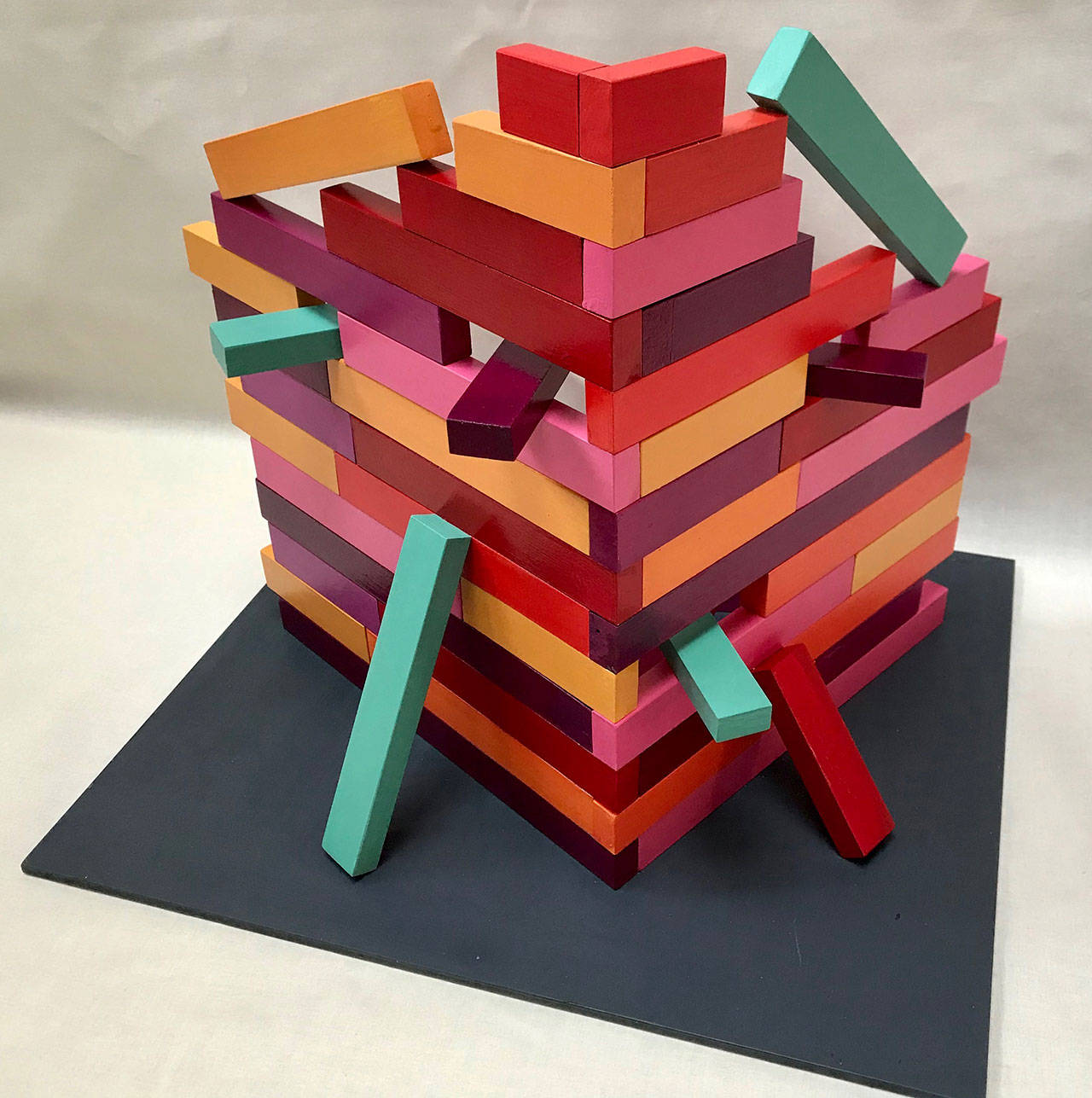First Friday has rolled around again, with new exhibitions opening in local art spots.
Gallery cruisers should limit their time at opening receptions, distance from those outside their own households, practice excellent hand hygiene, and of course, wear well-fitting face-coverings while they enjoy the art on display.
New at VALISE: ‘Sex and Territory’
A new exhibit at VALISE, “Sex and Territory,” is a visual response by gallery members to Margaret Atwood’s poem, February, published in her 1995 volume, “Morning in the Burned House.
Savor a few lines:
“February, month of despair,
with a skewered heart in the centre.
I think dire thoughts, and lust for French fries
with a splash of vinegar.”
The exhibit was the brainchild of VALISE member Jesse Johnson, a visual poet whose work bridges the traditional distinction between written text and visual representation. He’s also taught writing at San Quentin Prison and is the author of two published novels.
According to Johnson, Atwood’s poem “effectively evokes the angst and expectancy of late winter …. And is loaded with rich imagery that is ripe for visual interpretation.”
All of VALISE 13 member artists — Johnson, Gregory Burnham, Dot Cherch, Bill Jarcho, Pascale Judet, Corinne Lightweaver, Rachel LordKenaga, Robert Passig, Sharon Shaver, Hita von Mende, George Wright, Lenard Yen and Jiji Saunders — have works in the show.
“It’s irreverent and funny,” Saunders said of Atwood’s poem. And in the face of problems, Atwood calls on us to “‘get going on a little optimism around here.’”
The show is full of diverse interpretations of the poem.
Shaver’s work is a portrait of Atwood. Other VALISE artists, including Passig, were inspired by lines from the poem. Passig’s painting in the show is titled, “I think dire thoughts.”
The painting is part of Passig’s series on “Discards/Detritus.” In 2020, the City of Seattle purchased one of the paintings in this series.
Judet created a sculpture inspired by Atwood’s line, “Get rid of death. Celebrate increase.” She said that her sculpture made of colorful blocks is about “rebuilding and doing more with less” — something that is on many people’s minds a year into the COVID pandemic.
VALISE Gallery is open from 1 to 4 p.m. Fridays, Saturdays, and Sundays, with extensive safety protocols and masks and limited capacity.
The opening celebration for the show will take place from 6 to 8 p.m. Friday, March 5, and the show can also be previewed on Friday afternoon. The show runs through March 27. For more information, visit VALISEGallery.com.
VCA shows ‘Power of the Feminine’
Vashon Center for the Arts Gallery is celebrating Women’s History month, with “The Power of the Feminine,” a group show with art by Beverly Naidus, Carol Rashawnna Williams, Cyra Jane, and Kristen Reitz-Green.
According to Lynann Politte, gallery director, the show is about hope for the future.
“As we continue to navigate the healing from divisiveness and anger, women continue moving towards peace and unity and express this power in their art,” she said.
The show includes two collections by Beverly Naidus. “Healing Deities” is a series of digital paintings, where Naidus explores very contemporary interpretations of Buddhas, bodhisattvas, pagan gods, goddesses and yoginis, many of them breathing and/or sitting in the midst of challenging environments and social circumstances.
These paintings were inspired by the words of her son, Sam, when he asked her, at age 4, “Why are you always painting sick people?”
At the time, Naidus was recovering from an environmental illness caused by exposure to pesticides and was painting the portraits of the other sick individuals she had met in clinics. Her son’s question inspired her to focus on the healing journey. As she transformed her work, she began to get well. She saw this work as essential to not only the healing of individual trauma but also the collective trauma of our ecosystems and the living beings with them who are being assaulted by violence and pollution.
Naidus’ second collection, “Curtain Call: Portable Altars for Grief and Gratitude” is a series of cloth/paper hangings. Each one focuses on a different endangered creature or element, from honeybees to old-growth trees to clean air.
Naidus’ art is content-based rather than form-based, said Politte.
“While there are many artists who perfect their craft in one medium, mastering a medium has not motivated Beverly’s creative process,” Politte said. “Instead, she works with ideas and scavenges the materials necessary to make what she needs to say.”
Seattle artist Carol Rashawnna Williams, who also has work in the exhibit, believes in the power of art to build community, bridge community relationships and create authentic space for healing. Her “Reconstructing the Goddess” is a mixed media triptych representing each cultural trinities: Africa — Horus, Isis, Maat; India — Kali, Kalica, Kali; Gaya — Mother, Maiden, Crone; Christianity — Father, Son, Holy Spirit. The artist’s “Tree of Humanity” is based on the tree of life through the eyes of an African American gene pool, she said.
Paintings from Cyra Jane’s “Fire Liken” series are active expressionist paintings that focus on the power and magic of femininity.
Kristen Reitz-Green’s “We Rise” is a sea of “pink pussy” hats that she witnessed when she marched at the Seattle Women’s March on Jan. 21, 2017. It demonstrates the power of numbers and was the start of four years of a tumultuous presidency. With that presidency over, this piece marks the start of a new beginning.



